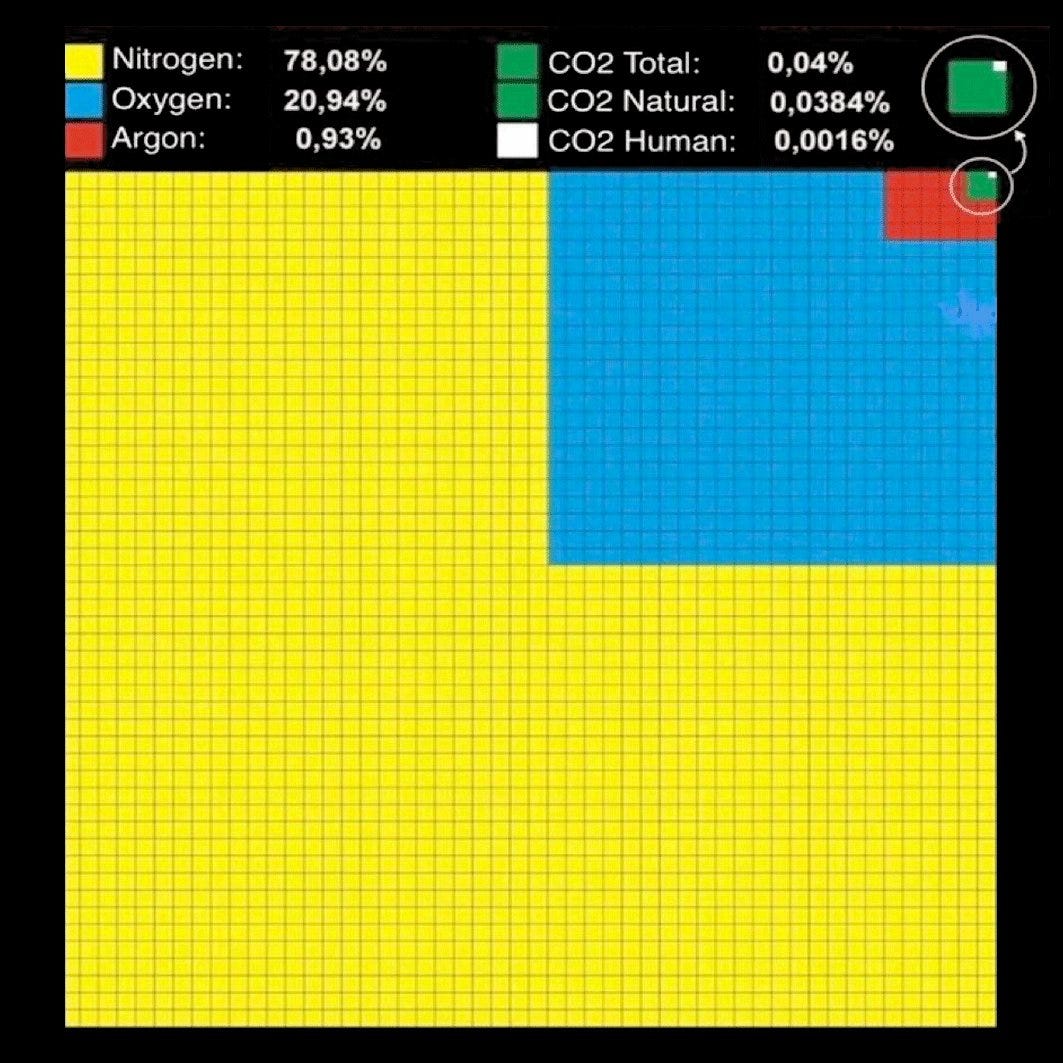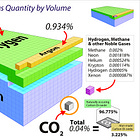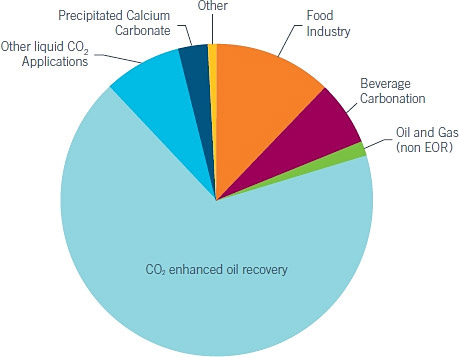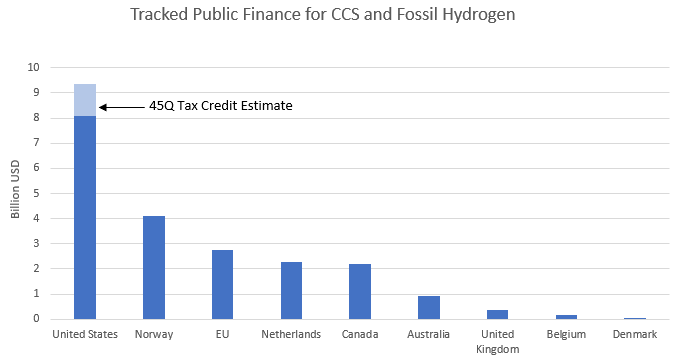Captured CO₂: 80% is Used by the Oil and Gas Industry
Enhanced oil recovery is the primary use for captured CO₂ - subsidized by your tax dollars
Carbon capture and storage (CCS) technology seeks to “mitigate greenhouse gas emissions” by trapping CO₂ from smokestacks and by direct air capture, followed by pumping the CO₂ deep underground. In reality, CO₂ enhances oil recovery as a solvent, by reducing hydrocarbon viscosity and also by displacement of gas and fluids. Source: USA DOE
Carbon capture is a very inefficient process because CO₂ is a trace gas at about 0.04 %, or 4 molecules in 10,000 (about 420 ppm). In the graphic, note the contribution of “human-made” CO₂, orders of magnitude less than “natural” CO₂. For simplicity sake, water is excluded in the graphic.
Preface
Dear Readers, thanks for stopping by again. We start this article with two very simple questions
Why would anyone in their right mind use an equivalent or greater amount of energy, typically from fossil fuels, to capture and sequester CO₂ from the air or industrial smokestacks?
Why would anyone inject CO₂ underground?
Given the above questions, common sense might also dictate that separating or distilling CO₂ from air would likely be highly inefficient, as CO₂ is extremely dilute in the air at only about 420 parts per million.
One might also surmise that this tiny amount of CO₂ is most likely not a major contributor to global warming, especially when compared to the massive forces exerted by the sun, moon, earth orbit, volcanoes, tectonic shifts, or water in the ocean/land/ice caps/atmosphere. These subjects and the thermodynamic efficiency of carbon capture (10 % on a good day) were covered in this previous article, coauthored by Dr. Gene Nelson of GreenNuke:
In this article we will explore the real reasons for CO₂ capture: that is, despite the high costs and inefficiencies of CO₂ capture, it remains a lucrative business for oil and gas companies and other companies such as Air Products and Linde. Three major reasons are as follows:
Carbon credit trading
Subsidies from your tax dollars
Profitable and legitimate industrial uses
The narrative that CO₂ is causing global warming has warped the CCS free-markets in terms of the 3 items above. Much of the worldwide CO₂ warming scare was catalyzed by the Supreme Court in Massachusetts v. EPA (2007) which ruled that CO₂ is a dangerous pollutant.
The ruling was rubber stamped as USA EPA policy on December 7, 2009, wherein the EPA Administrator signed two distinct findings regarding greenhouse gases under section 202(a) of the Clean Air Act, one of which is presented below:
EPA Endangerment Finding: The EPA Administrator finds that the current and projected concentrations of the six key well-mixed greenhouse gases—carbon dioxide (CO2), methane (CH4), nitrous oxide (N2O), hydrofluorocarbons (HFCs), perfluorocarbons (PFCs), and sulfur hexafluoride (SF6)—in the atmosphere threaten the public health and welfare of current and future generations.
Remarkably, CO₂ is the only “pollutant” that we know of that is required for life on Earth. The other gases listed by the EPA are not required for life on earth.
The ruling as adopted by the EPA, ultimately gave birth to the profiteering climate industrial complex, which has caused untold damage worldwide for many years to present.
Capture of CO2 for Enhanced Oil Recovery
Carbon capture and storage (CCS) is used to enhance oil recovery. CO₂ acts as a solvent, reducing hydrocarbon viscosity and by physical displacement of gas and fluids. Source: USA DOE
CO2 Enhanced Oil Recovery: from an Oilman’s Dream to a “Climate Solution”: the process of using carbon dioxide to produce more oil, now known industry-wide as enhanced oil recovery, or “CO2-EOR”, was born in the oil fields of Texas in the early 1970s. Petroleum engineers from leading oil producers such as Shell, Exxon, and Chevron had discovered that injecting CO2 at high pressure into “mature” or “previously developed” oil reservoirs helped increase the flow of otherwise stubborn hydrocarbons — in essence squeezing more volume out of aging wells. CO₂ enhances oil recovery by solvation, reducing oil and hydrocarbon viscosity and by displacement of gas and fluids.
“Of the 32 commercial carbon capture and storage technology facilities operating worldwide, 22 use most, or all, of their captured CO₂ to push more oil out of already tapped reservoirs.” Source: DeSmog.
Though initial tests found that each ton of injected CO2 could push out an additional two or more barrels of oil, the lack of readily available CO2 made the technique expensive. That changed when companies began siphoning off CO2 emitted from several Texas gas processing plants, and piping it to an oil field to boost productivity. To ensure a steady supply, industry agents scoured the region and purchased the rights to mine naturally occurring CO2 deposits in Colorado, New Mexico, and Arizona — eventually building hundreds of miles of dedicated pipelines to transport the gas to oil-field injection points.
By the late 1970s, amid growing concerns over what was then known as the “greenhouse effect,” industry executives began to propose that capturing CO2 and burying it underground could allow the world to continue generating power from fossil fuels far into the future. In 1992, the Paris-based International Energy Agency (IEA) and other energy organizations established a research program to support developers seeking to prove CCS at scale.
By the time of the first U.N. climate conferences in the mid-1990s, the oil industry had begun marketing carbon capture as a technological “silver bullet” capable of making coal “clean,” and rendering oil and gas as “low carbon” — a strategy employed by oil majors to this day.
Since the 1970s, billions of barrels of oil, once thought unrecoverable, have been extracted using CO2-EOR. Source: Denbury (Exxon)
Captured by CO₂, Brought to You by the USA Department of Energy
Above: approximately 80 % of commercial carbon dioxide is used for enhanced oil recovery. Source: USA DOE NETL.
Two Examples of Carbon Capture and Storage Operations for EOR: Exxon and Kinder Morgan
Above: note diverse ExxonMobil CCS site workers.
Above: Exxon CCS-EOR facilities are conveniently located in oil rich areas of extraction.
From ExxonMobil:
Our carbon capture and storage (CCS) network can help reduce carbon dioxide (CO2) emissions for key industries in the U.S. Our combined assets now include:
More than 1,500 miles of CO2 pipeline owned and operated – largest in the U.S.
Multiple strategically positioned storage sites across the U.S. Gulf Coast
The potential to reduce CO2 emissions by >100 million metric tons a year
Current capture capacity of 9 million metric tons per year.
We have cumulatively captured more CO2 than any other company – 120 million metric tons – accounting for approximately 40 percent of all the anthropogenic CO2 that has ever been captured.
Above: James Dean greeting his people in the iconic film Giant.
Kinder Morgan CO₂ SACROC Unit located in West Texas. Source: Kinder Morgan.
From: Kinder Morgan
Kinder Morgan CO₂ Company is the largest transporter of carbon dioxide in North America, transporting approximately 1.2 billion cubic feet per day of CO2 from our source fields in Southwest Colorado to New Mexico and West Texas for use in enhanced oil recovery (EOR) projects. The CO2 helps unlock and recover crude oil from mature oil fields and residual oil zones.
We use a good portion of this CO2 in our own EOR projects, and we sell CO2 to third-party customers. On the production side, we produce over 50,000 barrels of oil per day, much of which comes from our large SACROC Unit in the Permian Basin of West Texas. We use a long-term hedging strategy to mitigate risk and generate more stable prices from our oil production.
A key asset, the SACROC Unit located in West Texas, is one of the largest oilfields and one of the oldest operating Carbon Capture and injection projects in the U.S. At the time of this project the SACROC Unit processed over 620 MMSCF/d of gas for CO2 capture and injection while recovering over 30,000 bbl/d of oil and 15,000 bbl/d of NGL liquids. Currently the SACROC Unit processes nearly 1 BSCF/d of gas for CO2 capture and injection.
Carbon Capture Will Extend Oil Production by 84 Years, Industry Study Finds From: DeSmog
Wild Bonanza of Tax Dollars and Credits for America’s Carbon Capture
Courtesy of the USA taxpayers: tax credits for the sequestration of “carbon oxide”, per section 45Q of the Internal Revenue Code
The Inflation Reduction Act (IRA) enhanced and expanded the Section 45Q tax credit by increasing the tax credit value, extending the construction deadline, and lowering the qualification threshold.
Specifically, the IRA increased the tax credits available under Section 45Q to $85 per metric ton for captured carbon that is stored in geologic formations, $60 per metric ton for the use of captured carbon to produce low and zero carbon fuels, chemicals, building materials, and other products, and $60 per metric ton for captured carbon that is stored in oil and gas fields, all assuming the wage and apprenticeship requirements are met.
In addition to extending the date by which construction must begin by seven years to Jan. 1, 2033, the IRA significantly reduced the amount of carbon oxide (generally, carbon dioxide) that a facility must capture to be eligible for the tax credit under Section 45Q.
Previously, electricity generating facilities were required to capture at least 500,000 metric tons per year, and industrial facilities were required to capture at least 100,000 metric tons per year. The IRA reduced those thresholds to 18,750 metric tons per year and 12,500 metric tons per year, respectively. These lower thresholds may open up new opportunities for entities that were previously scaled out. Source: Reuters.
Pilgrims can claim their carbon oxide tax credit here.
Tracking Taxpayer Subsidies and Government Credits for Carbon Capture
Above: Governments have spent over $20 billion – and have legislated or announced policies that could spend up to $200 billion more – of public money on CCS, providing a lifeline for the fossil fuel industry.
Conclusions
Carbon capture and storage is a highly inefficient process, perhaps less than 10 % thermodynamic efficiency.
To make carbon capture and storage “profitable”, tax credits and other incentives are used.
CO2 injection or “storage” is a useful method to recover oil and gas from non-productive and moribund wells. Billions of gallons of oil have been recovered using CO2.
80 % of all CO2 is used by the oil and gas industry for enhanced recovery.
CO2 - EOR Clickable Tidbits
The Inflation Reduction Act Includes a Bonanza for the Carbon Capture Industry
Carbon Capture Will Extend Oil Production by 84 Years, Industry Study Finds
How Carbon Capture and Storage Projects Are Driving New Oil and Gas Extraction Globally
Companies capture a lot of CO2. Most of it is going into new oil.
California hopes to fight global warming by pumping CO2 underground. Some call it a ruse
Extra CO2 Bonus Section
Above: CO2 instant ice cream gains patent: A newly patented process using pressurized carbon dioxide can create instant ice cream.
Above: the Iconic.
Insomnia? Here You Go
DownloDetailed PDFs, IRS 45q and IRA.






















Thank you for stopping by and the thoughtful comment.
Welcome to the Bermuda Triangle 📐 of Carbon Capture.
"However, capturing CO2 is not the same as avoiding its climate impacts. If that CO2 is then used to directly produce more oil, or if CCS “abatement” is used to suggest that additional oil and gas production is climate-friendly — or in some cases both — then those CCS projects are invariably acting as a net harm to the climate, by actually increasing overall CO2 pollution. From: DeSmog"
I'm having trouble with this. It would be one thing if CO2 were produced specifically for this purpose. But it's CO2 that was headed to the atmosphere anyway, and petroleum will be pumped, one way or another. Some of the CO2 will remain in the ground, making for a net minus in atmospheric CO2, as relates to this process.
It's not unlike turning on the heater in your ICE car. That heat costs nothing EXTRA. The fuel has already been burned. Now, you can send the heat out the radiator, and send some of it into the car.
I have no doubt that the green energy movement is 110% a scam. But that's a topic for another day.